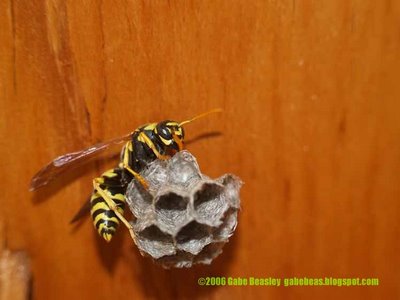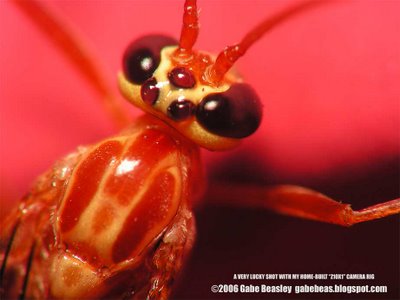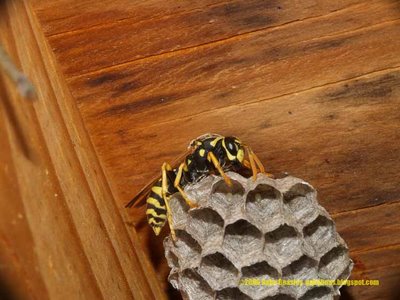
THE STORY OF THE HIVE
Lucky enough to survive the winter, she emerged into a cold world stacked against her, but somehow found a way to survive all on her own for now. First she has to find a spot free of wind&rain, bright sun, and animals that may disturb the nest. She got lucky and landed on a good side of a house of an amateur naturalist and not your typical local resident here. She had to grow up fast--and learned how to make paper from the instructions given to her in her by nature written in countless lines of genetic processes. Just like you cried as a newborn baby when you needed something, her instructions told her allot more! In a similar but far more complex way to do what she does. Instinct. Of course she had to know allot more then just how to get food when she grew up as a grub last year. She becomes a hard worker and truly loving mother. If she lives through the cold nights and many dangers with humans and predators--in a few weeks she will finally have a family.

This is where she has to find building materials. I observed how they do this while in my yard photographing and watching other insects. They painstakingly come down and chew up old stuff like these weed sticks from last year. I've heard they will use many kinds of different materials to make there paper. If they were able to make it in sheets--you could make a book out of it! As can be seen from the close-up pictures it's incredibly well done. I've always been fascinated with paper making wasps and insects that can build there own homes. They mix saliva and chewed up materials like this in order to build there hive which can stand up to serious stress and weather. This picture is of the exact material I observed them using. They feed on nectar, cherries, peaches and just about anything they can find. They don't want to sting you and sometimes they will just "buzz" you or bite--they do not want to waste valuable protein on venom.
 Now she sleeps so un-aware I took over 25 pictures of her and she did not even move. I had a bright light on her and fired a bright flash right at her being about six inches away with my macro lens, this one now having finally found a place to begin her home may have been flying for weeks. Soon she will be just like the one pictured BELOW tending to a nest and the eggs she will lay in it.
Now she sleeps so un-aware I took over 25 pictures of her and she did not even move. I had a bright light on her and fired a bright flash right at her being about six inches away with my macro lens, this one now having finally found a place to begin her home may have been flying for weeks. Soon she will be just like the one pictured BELOW tending to a nest and the eggs she will lay in it.She has eggs already developing from weeks ago when she had to leave her first home where she was born. Then alone she has lived long enough to find the raw materials to build her home. Paper wasps and hornets amaze me. The fact that they survive with so many odds stacked against them is incredible. Since many of them don't have massive hives like bees it's a wonder they live. Millions of cans of bug sprays are sold and billions of these interesting hard working insects are simply killed at will without a second thought. It's almost sad, she is trying to build a home and a family so she finally can live no longer alone. Fighting against all those odds. I will let her live-and in future articles we will see what she does and learn first hand how the nest works. The odds are still against her. Even if the grubs survive--they cannot take care of themselves. Until there are more adults, if the mother dies---the whole nest dies. It's not uncommon to see nests this small un-occupied. Those are the ones that never made it back.
 She tends to each egg in it's nice secure spot. Keeping it clean from small insects and any kind of bacteria which may grow near them. She is a kind and caring mother who will take on any and all who approach her. Yet all I did was get on a chair and hold my camera right up next to her. At six inches away she looked at me and then continued to go about her work. Clearly not as aggressive as one might think. I was careful--hornets do several body postures to look for (just like most any dangerous animals). It takes time and hands on experience to learn when spiders, insects, bees and wasps are ok to get close to. LEARN SUCH THINGS AT YOUR OWN RISK!
She tends to each egg in it's nice secure spot. Keeping it clean from small insects and any kind of bacteria which may grow near them. She is a kind and caring mother who will take on any and all who approach her. Yet all I did was get on a chair and hold my camera right up next to her. At six inches away she looked at me and then continued to go about her work. Clearly not as aggressive as one might think. I was careful--hornets do several body postures to look for (just like most any dangerous animals). It takes time and hands on experience to learn when spiders, insects, bees and wasps are ok to get close to. LEARN SUCH THINGS AT YOUR OWN RISK!
I was bold and careful with the lens I usually use. It gives me about 6 inches clearance even at it's tightest zoom. I did not get stung, or for that matter even buzzed--by these hornets. I was aware however and backed off several times when I noticed warning signs which make me think I'm pushing my luck. It would have been better for me to have used a bellows system and shot these in 35mm. A clearance of over a foot is a really good idea and can be done with some good macro gear. I have it but knowing I could pull these shots off with digital I chose to take the risk. I know I’m not allergic because I’ve been stung before. You never know until you are stung. Many people get stung and bitten by insects and blame it on spiders. In reality spiders bite far less people then insects. I guess that over 75% of bites people call “spider bites”--usually because they see a spider on there wall or something---are actually insect bites or skin conditions that get out of hand.
 Now our Sandhills hornet has made her hive good and large--she rests and night and drinks nectar by day--getting ready to raize her family of nearly a dozen of her children. If she is killed outside of this nest---they will all die. It's up to her and she has no help from other hornets. A great deal of responsibility which will be rewarded.
Now our Sandhills hornet has made her hive good and large--she rests and night and drinks nectar by day--getting ready to raize her family of nearly a dozen of her children. If she is killed outside of this nest---they will all die. It's up to her and she has no help from other hornets. A great deal of responsibility which will be rewarded.NO--the daddy longlegs is not the most poisonous spider in the world. (I have no idea who made that crap up). And NO a spider with “boxing gloves” near it’s mouth does not mean that it is a brown recluse or a dangerous hobo spider. Those “boxing gloves” are found in all species of spiders--they make it very easy to tell male from female spiders. They are part of the male reproductive system of all spiders. More then %50 of "spider bites" are actually insect bites caused by the common true-bugs, ants, small bees, wasps and other species which also get into our homes and travel with us. Usually people jump "spider bite" without seeing a spider or they find one on there wall and asume it's responsible. In ALL CASES try to catch what bit you dead or alive and bring it to the hospital if you get sick--this can be very important.
HAVE A QUESTION ABOUT INSECT BITES OR STINGS?
E-mail me or leave a comment but BE SURE leave a return e-mail address!
 "Short-tailed" Ichneumons (p810) (ABOVE and BELOW) This is a gruesome relative of the wasp. It's odd head seems to feature noticeable extra-eyes (Below). I have a number of full body shots but they were not processed yet so I thought I'd put this one (forgive the underexposure) in showing it's strange eye-arrangement and the whole insect. Actually many insects including honey bees, ants, praying mantises, and flies have these three extra eyes but they are usually not visible to the naked human eye.
"Short-tailed" Ichneumons (p810) (ABOVE and BELOW) This is a gruesome relative of the wasp. It's odd head seems to feature noticeable extra-eyes (Below). I have a number of full body shots but they were not processed yet so I thought I'd put this one (forgive the underexposure) in showing it's strange eye-arrangement and the whole insect. Actually many insects including honey bees, ants, praying mantises, and flies have these three extra eyes but they are usually not visible to the naked human eye.ICHNEUMONS the gruesome facts-
This wasp starts it's life as a parasite inside large caterpillars. They are very common here. The mature females will lay her eggs inside a living caterpillar--as it matures and keeps growing the tiny Ichneumon wasps grow into larva and literally eat the caterpillar alive. Pods bulge out from the brain dead caterpillar and the wasps emerge from it's body. Now that makes even my skin crawl!
 (ABOVE) Finally identified, this wasp I have shown before on my site. Here is more on it. Are those eyes a means to nighttime navigation? I am not sure--but this is a nocturnal insect and the eyes seem to prove that.
(ABOVE) Finally identified, this wasp I have shown before on my site. Here is more on it. Are those eyes a means to nighttime navigation? I am not sure--but this is a nocturnal insect and the eyes seem to prove that.This wasp is small--and NO-- it can't grow in people! It is not considered a dangerous insect but may have a mild sting (I honestly don't know). The head of this particular wasp is only about 1.5-2mm across. Some researchers use insects like these to kill pest species. I disagree with the introduction of any new species into an environment even to take care of a mistake we made--but they usually do it anyway with allot of controversy. We have messed with nature bad enough--we don't need to more. I grew up with several disasters in Hawaii caused by incompetent scientists. They introduced a wasp much like this one to control the star-spider population (and hopefully eradicate it) because of there painful bites in the coffee and sugar cane fields. Well--in no less then three years another species which had been living only in isolated areas came up out of nowhere with a similar bite and produced an even worse spider problem to which there is now no answer as this wasp they introduced only kills that one particular species. Now there are twice as many biting spiders out there last I saw--this species overlooked filled a part in the food-chain that vanished with the demise of the star-spider. Messing with nature often backfires when introducing species to islands but the use of harmful bugs by adding more of them (like lady bugs) is often a very good idea.
 FLASHBACK SHOT
FLASHBACK SHOTThis probably daylight active Ichneumon wasp I managed to photograph luckily last year. I have not seen another one since then. The vacant lot where I photographed it has been destroyed for development. This one has a much longer Ovipositor. These specialized kinds of wasps can only survive parasitically. It's an evolutionary paradox kind of like the chicken and the egg. What came first? However they are as interesting as they are gruesome. Some lay there eggs in plants where they create galls on trees and plants--and far worse on caterpillars and a few other insects with very long ovipositors. These micro-syringes are sharp enough to go through an entire apple to get to a worm inside it--find the worm and inject a tiny egg. This one was also small and I was only able to get one lucky shot of it before it flew off. I have published it before but I brought it up again in order to show this article about some of the local wasps here in The Dalles Oregon.

On top of her enlarged nest, she guards it well yet as seen in above pictures seems to get very sleepy! In time more of the raw materials that are easy to find will be slowly collected by her offspring and the hive will get larger. They will view her as the queen with a powerful respectful bond who I believe gives them some small degree of orders but nothing like the complexity of honey bees. Click on picture to see the eggs in the cells.
REMOVEING DANGEROUS NESTS
The method I use is a simple garden hose with a hand-grip spray handle from a distance. Shooting them off until they can't fly and blasting the nest away. If it is broken off they will not return or re-build after a few tries. If you do use spray them with anything--even bug spray that claims to kill in seconds, they will often get the last word if you are cocky and disrespectful while doing it. Remember--insect sprays KILL EVERYTHING helpful bugs, spiders, plants, pets AND humans. Most people and kids get stung because they are either working right next to a nest and unaware of it, OR they are purposefully toying with the nest and or tormenting the dieing ones. DO NOT be stupid.

Ever ready to defend- she will stand poised to attack if I were to move my macro lens closer to her An important point here--these hornets will defend themselves. If you get too close with a camera or macro lens or your eyes, you are taking a great risk of being stung. She does NOT want to sting you. In fact this shot was taken at about six inches away from her nest. Only six inches between the end of my macro lens and the wasp. She does not want to waste valuable protein on stinging you. She is afraid for her family. What would you do if a huge animal was apparently about to run into or attack your house full of newborns?
 In this view if you click on it you can clearly see the beginnings of her family. Each cell has a single egg in it. The egg will hatch and a grub will begin to grow. The mother has to hand feed each one of them until they are closed up by the mother in there transformation from a grub into a wasp. After that time they are sealed inside these cells as they develop just like a caterpillar does inside paper instead of a cocoon. It is sealed inside with no extra food or water to transform into a new adult wasp.
In this view if you click on it you can clearly see the beginnings of her family. Each cell has a single egg in it. The egg will hatch and a grub will begin to grow. The mother has to hand feed each one of them until they are closed up by the mother in there transformation from a grub into a wasp. After that time they are sealed inside these cells as they develop just like a caterpillar does inside paper instead of a cocoon. It is sealed inside with no extra food or water to transform into a new adult wasp.
Even my most close up shots of her were done at about six inches away. I had to hold the camera above me--luckily my D-SLR not the heaviest in the world but since I don't have a viewfinder add-on. I was forced to focus by looking into the viewfinder at a distance and then shoot by trial and error. I spent allot of time around two nests with new mothers who had just laid un-hatched eggs--I was threatened by a dirty looks--but nothing more. When sleeping she was motionless and apparently not aware of me--I did not know that these kinds of insects could become so un-aware. I suppose she should be tired--after all, have you ever tried to build a house and raise ten kids in just a few months?
1 comment:
Mini trucks?
What's a mini truck?
I have no such blogsite!
Sorry, you must have the wrong guy.
-G.Beasley (sysop-Spiders insects other
pics) (Mostly Macros)
Post a Comment